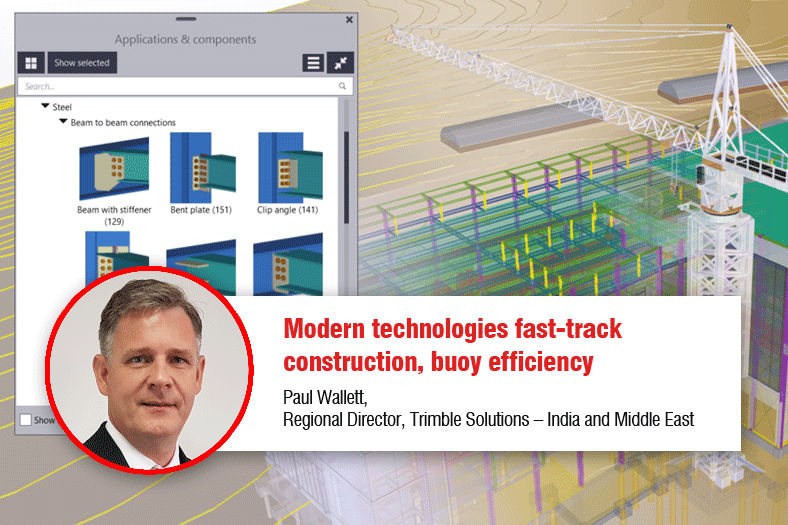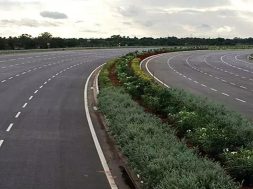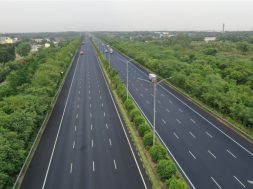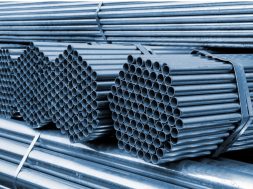Modern technologies fast-track construction, buoy efficiency

Technology is an essential building block for making a cities smart. According to Paul Wallett, Regional Director, Trimble Solutions – India and Middle East, developing smart and sustainable buildings or structures is perhaps one of the most important, but often understated aspect of creating smarter cities, which is now possible with modern construction technologies.
How can your technology contribute to make better smart cities?
Sustainable buildings are known to reduce waste generation. Using Tekla Structures, the ‘constructability’ of a building can be tested much ahead in time, inside a virtual model, and thus rework and material wastage can be minimised.
Trimble emphasises on Constructible BIM instead of vanilla BIM. Unlike conventional BIM-based software solutions that have been designed essentially for architects, new-age BIM solutions from companies like Tekla are useful for all stakeholders in the construction lifecycle, right from architects to structural firms to building and MEP contractors and real estate companies.
Given the large number of stakeholders involved in building a smart city, it is important that there is effective collaboration amongst them. Tools like Trimble Connect and Tekla Model Sharing allow project teams to work together efficiently, regardless of their location or time zone. Trimble Connect provides users with better visibility into a project’s status, reduces guesswork and offers better predictability of the costing and completion of the project.
What are the latest construction trends in IoT with respect to smart cities?
Experts predict the IoT will transform construction by 2025 through automation, software, prefabrication and 3D printing. With IoT, industry professionals can now use technology right through the lifecycle of construction, build structures that reduce the emissions and thus make earth a better and more sustainable place. In the building stage, IoT allows construction workers, machinery and materials to ‘talk’ to a central data platform (BIM) that captures critical performance parameters.
After the building is ready for occupation, IoT can be used to efficiently manage and maintain the building. As an example, the model can be used for developing an annual maintenance plan or to easily locate parts that require maintenance. IoT can also play an important role in the maintenance of critical building equipment like HVAC, elevators and escalators. Sensor data can monitor patterns in key stress indicators, such as temperature or vibration patterns.
Please talk about your latest innovation?
Trimble Connect for HoloLens is a great example of how technology is aiding smart cities by making entire construction process smarter and more efficient. With this new technology, one can identify such problem areas ahead of actual construction and create designs that are smarter and sustainable. It uses ‘mixed reality’ for project coordination allowing construction professionals to visualise their 3D models as holograms placed in the real world. This technology has the potential of greatly improving the safety of the construction site by allowing for a more elaborate safety plan to be designed as well as providing training on heavy equipment on real sites with augmented hazards. The outcomes are improved productivity, enhanced production control and a better output.
What is the major technological challenge faced related to smart cities?
There are many technological challenges for smart cities; including ensuring security and privacy of citizens’ data, ensuring that variety of applications are interoperable and able to share data with one another, educating communities and so on. But fundamentally, when it comes to construction industry, the biggest challenge in my opinion is adoption. Indian construction industry is yet to fully realise the power of technology and the potential it holds. It still depends heavily on conventional methods of construction, and that is a huge hindrance. Smart cities cannot be made without the help of smart technology.
Experts predict IoT will transform construction by 2025 through automation, software, prefabrication,3D printing.
Paul Wallett, Regional Director, Trimble Solutions – India and Middle East
14
Cookie Consent
We use cookies to personalize your experience. By continuing to visit this website you agree to our Terms & Conditions, Privacy Policy and Cookie Policy.








